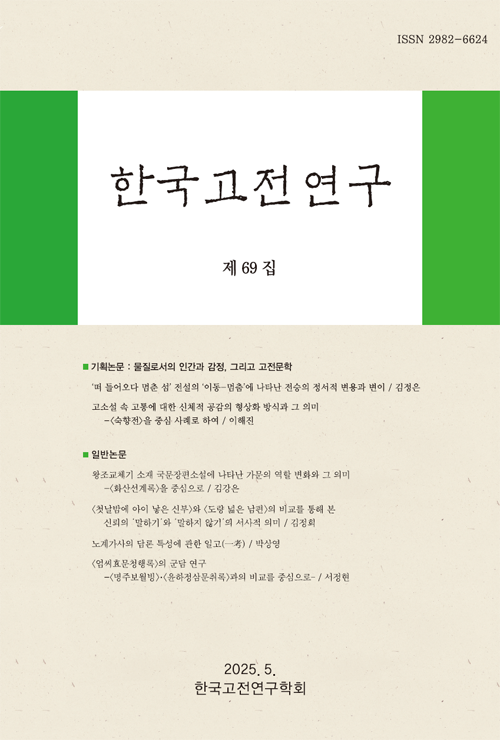- 영문명
- The Aesthetic Consciousness Reflected in Nam Yoo-yong’s Appreciation of Painting and Poetic Representation
- 발행기관
- 한국고전연구학회
- 저자명
- 하지영(Ji-young Ha)
- 간행물 정보
- 『한국고전연구(韓國古典硏究)』제70권, 251~284쪽, 전체 34쪽
- 주제분류
- 인문학 > 문학
- 파일형태
- 발행일자
- 2025.08.31

국문 초록
본고는 남유용(南有容)을 사례로 조선 후기 사대부들의 서화 향유와 문학 창작 사이를 관통하는 심미 의식을 탐색하고자 하였다. 서화 애호가인 동시에 스스로 화가이기도 하였던 남유용은 자신이 창작하거나 감상한 서화, 그리고 서화가에 대한 다수의 기록을 남겼다. 그는 천지자연에 궁극의 미가 내재되어 있다고 주장하며, 물상에 대한 깊은 관조, 교감을 통해 조화의 오묘함을 획득하고 나아가 자신의 의취(意趣)를 표현해내는 작업으로서의 그림의 가치를 부각하였다. 초상화에 대한 논의에서는 대상의 형상과 함께 이에 내재한 정신이 화가에게 잘 포착되어 그림으로 형상화되고, 대상의 정신이 다시 감상자에게 전달되는 효용성을 강조하였다. 이러한 회화론으로 인해, 남유용은 작품에 대해 실증적으로 접근하기보다는 작품의 도상이 지닌 의미와 함께 작가의 의도를 파악하고자 하는, 주관적인 감상 태도를 특징적으로 보인다. 이상의 회화 창작론과 감상론은 그의 제화 시문(題畵詩文)에도 반영되어, 깊이 있는 교감과 상상력을 바탕으로 도상을 동태(動態)로 재현해 냄으로써 작품이 지니고 있는 정취를 증폭시키거나 작화의 의도를 적극적으로 해석하는 경향을 드러낸다.
회화론과 제화 시문에서 확인되는 남유용의 심미 의식 및 형상화 방식은 여타의 시문학에서도 확인된다. 그는 시에서 추구해야 하는 궁극의 미 역시 천지자연에 있는 것으로 보아, 자연스러운 감정의 발로, 인위적인 조탁의 배제, 참신한 시어와 의경을 추구하였다. 그의 한시는 깊이 있는 관조의 과정을 거친 회화성이 돋보이며 주변의 풍경과 소소한 경험을 참신하고도 담박하게 시화하였다는 점에서 문예적 성취를 보이나, 현실을 직시하거나 당면한 문제를 예각화하는 데는 무용했다는 점에서 한계를 드러낸다. 이러한 한시의 심미화, 탈속화 경향은 그의 회화 감상 취미와 무관하지 않으며, 나아가 18세기 경화 사족 특유의 낙관적이고, 낭만적인 현실 인식과도 일정한 관련성을 보인다.
영문 초록
This study explores the aesthetic consciousness that links the appreciation of painting and literary creation among the literati of late Joseon, using Nam Yoo-yong (1628-1692) as a representative case. Nam Yoo-yong was not only an avid admirer of painting but also a painter himself, and he left behind numerous records regarding the paintings he created or appreciated, as well as the painters with whom he interacted. He asserted that the ultimate beauty resides in the natural order of heaven and earth, emphasizing the value of painting as an act of expressing one's artistic intent through profound contemplation and emotional communion with objects. In his discussion of portraiture, Nam highlighted the efficacy of painting in capturing not only the external form of a subject but also the inner spirit, which the artist should discern and convey to the viewer.
Such views led Nam to adopt a characteristically subjective mode of appreciation, favoring interpretation of the iconographic meanings and the artist’s intentions over empirical or formalist analysis. His theories of artistic creation and appreciation are also reflected in his poems on paintings(jehwa si-mun, 題畵詩文), where he often reinterprets visual motifs dynamically through deep empathy and imagination, thereby amplifying the emotional resonance of the artwork or actively decoding its intended message.
Nam Yoo-yong's aesthetic sensibility and representational strategies, evident in both his art theory and his poems on paintings, are likewise present in his other poetic works. He regarded the ultimate beauty in poetry as rooted in the natural world, advocating for the spontaneous expression of emotion, the avoidance of artificial embellishment, and the pursuit of novel diction and imagery. His Chinese-style poetry (hansi) is notable for its painterly qualities, derived from contemplative engagement with everyday scenes and experiences, expressed in a fresh yet restrained manner. While such literary achievements are significant, his poetry shows limitations in confronting social realities or articulating critical perspectives on contemporary issues. This tendency toward aestheticization and transcendence in his poetry reflects not only his interests in art appreciation but also aligns with the optimistic and romantic worldview characteristic of the 18th-century Gyeonghwa aristocracy.
목차
1. 서론
2. 서화 향유와 회화론
3. 회화 감상의 문학적 형상화
4. 한시에 나타난 심미 의식과 회화성
5. 결론
참고문헌
키워드
해당간행물 수록 논문
참고문헌
- 학자원
- 소명출판
- 동방한문학
- 문헌과 해석
- 경상대학교 석사학위논문
- 韓國漢詩硏究
- 한국한시작가연구
- 동방한문학
- 성균관대학교 박사학위논문
- 이화여자대학교 박사학위논문
- 漢文古典硏究
- 한양대학교 출판부
- 연세대학교 박사학위논문
최근 이용한 논문
교보eBook 첫 방문을 환영 합니다!

신규가입 혜택 지급이 완료 되었습니다.
바로 사용 가능한 교보e캐시 1,000원 (유효기간 7일)
지금 바로 교보eBook의 다양한 콘텐츠를 이용해 보세요!



